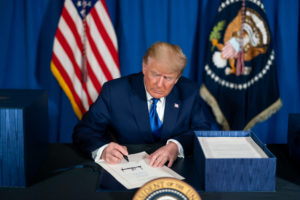
COVID-19 aid bill adds $20B more for ‘targeted’ EIDL advances; some body shops might be eligible
By onBusiness Practices | Legal | Market Trends | Repair Operations
In addition to permitting a new wave of PPP assistance, the massive COVID-19 relief bill approved Sunday allots more money to the popular Economic Injury Disaster Loan advance program.
Congress passed House Resolution 133 on Dec. 21, and Republican President Donald Trump signed it on Sunday after initially threatening to veto the coronavirus support measure.
“I am signing this bill to restore unemployment benefits, stop evictions, provide rental assistance, add money for PPP, return our airline workers back to work, add substantially more money for vaccine distribution, and much more,” Trump said in a statement Sunday that protested the lack of $2,000 checks for Americans and what he called “wasteful items” within the measure.
He said he would request Congress make cuts, but unlike a veto, this rescission attempt has no official power and is merely a suggestion, according to the Association Press. At this point, H.R. 133 stands on the books as law.
This means auto body shops who found themselves down 25 percent in a quarter this year and have no more than 300 employees will be able to apply for more PPP assistance.
EIDL advances
It also means certain shops applying for coronavirus-related Economic Injury Disaster Loans have a new opportunity to seek an advance on the debt — and keep the money regardless of whether the loan is approved. Applicants can request up to $10,000 of what’s essentially free money.
The 3.75 percent, potentially 30-year EIDL loans themselves were deferrable for a year.
They can be used for “(w)orking capital & normal operating expenses,” according to the SBA.
Though COVID-19 EIDL loans continue to be available, the EIDL advance program ran out of money in July, with all $20 billion ultimately disbursed to more than 5.8 million American businesses as of July 14.
Congress appropriated another $20 billion Dec. 21 to restock the initiative through Dec. 31, though $20 million of that is earmarked for the Inspector General “to prevent waste, fraud, and abuse with respect to funding made available under that section.”
The process won’t be as rushed or as open as the previous EIDL advance program, which gave the SBA just three days to approve the $10,000 advances if a borrower self-certified eligibility.
The new HR 133 allocates the new $19.98 billion worth of EIDL advances for companies within low-income communities who saw a 30 percent reduction in business during any eight-week period between March 2 and Dec. 31. The businesses cannot have more than 300 employees.
Low-income community is defined in 26 USC 45D(e) as a population census tract where “the poverty rate for such tract is at least 20 percent” or:
(i) in the case of a tract not located within a metropolitan area, the median family income for such tract does not exceed 80 percent of statewide median family income, or
(ii) in the case of a tract located within a metropolitan area, the median family income for such tract does not exceed 80 percent of the greater of statewide median family income or the metropolitan area median family income.
Eligible low-income community businesses who collected less than the max $10,000 advance the first time can claim the difference now. Any eligible businesses who applied for an EIDL but were denied an advance because the program had been out of money can apply for the full $10,000.
Under the spring CARES Act, SBA could approve EIDL loan applicants based on credit score alone “and shall not require an applicant to submit a tax return or a tax return transcript for such approval.”
The new HR 133 deleted this restriction on requesting a tax return, potentially beefing up the oversight for the loans.
It also specified that the SBA could use Treasury Department information to verify the applicant’s eligibility or “the information contained in an application for such a loan is accurate.”
Rather than have just three days to disseminate the money, the SBA will have three weeks to vet the advance applicant.
(B) TIMING.—With respect to each request submitted to the Administrator under subparagraph (A), the Administrator shall, not later than 21 days after the date on which the Administrator receives the request—
(i) verify whether the entity is an entity that is eligible for a loan made under section 7(b)(2) of the Small Business Act (15 U.S.C. 636(b)(2)) during the covered period, as described in subsection (b);
(ii) if the Administrator, under clause (i), verifies that the entity submitting the request is an entity that is eligible, as described in that clause, provide the advance requested by the entity; and
(iii) with respect to an entity that the Administrator determines is not entitled to receive an advance under this subsection, provide the entity with a notification explaining why the Administrator reached that determination.
Congress also retroactively repealed a requirement for Paycheck Protection Program forgiveness to be reduced by the amount of the EIDL advances.
“It is the sense of Congress that borrowers of loans made under section 7(b)(2) of the Small Business Act (15 U.S.C. 636(b)(2)) in response to COVID–19 during the covered period should be made whole, without regard to whether those borrowers are eligible for forgiveness with respect to those loans,” HR 133 states.
Anyone who already had a PPP loan forgiven and so deducted must be repaid the difference, according to the new law.
The new law also makes it clear to the IRS that any expenses purchased with EIDL advances are deductible, even though the business who got the grant effectively received free money.
More information:
Small Business Administration COVID-19 EIDL webpage
Featured image: Republican President Donald Trump signs House Resolution 133, which contains a new round of COVID-19 relief for businesses. trillion for coronavirus stimulus and government funding. (Shealah Craighead/White House)
